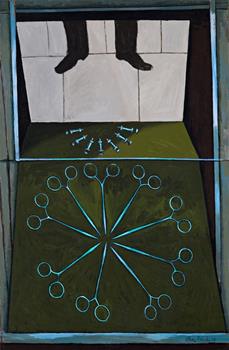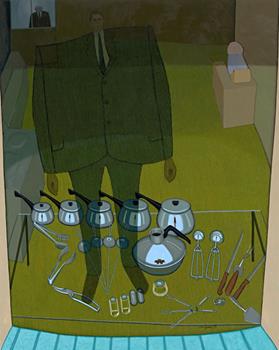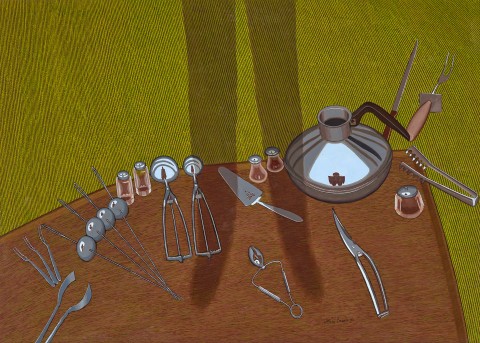THROUGH THE WINDOW, 1972
JOHN BRACK
oil on canvas
82.5 x 116.0 cm
signed and dated lower right: John Brack 72
inscribed with title on handwritten label attached to stretcher bar verso: ‘THROUGH THE / WINDOW’
Joseph Brown Gallery, Melbourne
Tolarno Galleries, Melbourne
The National Australia Bank Art Collection, acquired from the above in 1978 (label attached verso)
Spring Exhibition 1972, Joseph Brown Gallery, Melbourne, 8 – 24 November 1972, cat. 56 (illus. in exhibition catalogue)
John Brack, Rudy Komon Gallery, Sydney, 10 – 28 November 1973, cat. 15
John Brack: selected paintings and drawings 1947–1977, Royal Melbourne Institute of Technology Gallery, Melbourne, 15 March – 1 April 1977, cat. 30
John Brack: paintings and drawings 1945–1977, Australian National University, Canberra, 21 September – 6 October 1977, cat. 36
The Seventies: Australian Paintings and Tapestries from the Collection of National Australia Bank, National Gallery of Victoria, Melbourne, 15 October – 28 November 1982
John Brack: A Retrospective Exhibition, National Gallery of Victoria, Melbourne, 10 December 1987 – 31 January 1988, cat. 85
The Seventies: Australian Paintings and Tapestries from the Collection of National Australia Bank, Geelong Art Gallery, Victoria, 30 April - 29 May 1988
The Seventies Exhibition: Selected Paintings from the National Australia Bank Collection, MacLaurin Hall, The University of Sydney, Sydney, 6 September - 1 October 1989, cat. 4
'The Seventies' Exhibition: Selected Paintings from the National Australia Bank Collection 'Modern Art of the Seventies', Caulfield Arts Complex, Melbourne, 18 January - 11 February 1990, cat. 2
The Seventies: Contemporary Australian Paintings from the National Australia Bank Collection, organised by Regional Galleries Association of New South Wales, New South Wales, cat. 4; and touring, Tamworth City Art Gallery, New South Wales, 24 May – 24 June 1990; Dubbo Regional Art Gallery, New South Wales, 11 July – 6 August 1990; Wagga Wagga City Art Gallery, New South Wales, 17 August – 10 September 1990; Moree Plains Regional Gallery, New South Wales, 3 October – 31 October 1990
Arrangement Australian Still Life 1973 - 1993, Heide Museum of Modern Art, Melbourne, 15 November 1993 - 25 January 1994
John Brack – Selected Paintings 1950s – 1990s, Geelong Art Gallery, Victoria, 15 June – 14 July 1996, cat. 10
Lindsay, R., The Seventies: Australian Paintings and Tapestries from the Collection of National Australia Bank, The National Bank of Australasia, Melbourne, 1982, pl. 15, p. 28 (illus.)
Lindsay, R., John Brack: A Retrospective Exhibition, National Gallery of Victoria, Melbourne, 1987, pl. 85, p. 65 (illus.)
Grishin, S., The Art of John Brack, Oxford University Press, Melbourne, 1990, vol. I, p. 124; vol. II, cat. o202, pp. 28, 147 (illus.)
Fenner, F., 'The Good Life: Paintings lost in the 70s', Tamworth Daily Leader, New South Wales, 1 June 1990
Inside and Outside (The Shop Window), 1972, oil on canvas, 164.0 x 130.5 cm, in the collection of the National Gallery of Australia, Canberra
‘What I paint most is what interests me most, that is, people; the Human Condition… A large part of the motive… is the desire to understand, and if possible, to illuminate… My material is what lies nearest to hand, the people and the things I know best.’1
210721 The Rosette.jpg

As a painter of modern life, John Brack found subjects in his immediate surroundings, the suburbs and the city of Melbourne. His best-known paintings of 1950s Australia, such as The New House, 1953 (Art Gallery of New South Wales) and the iconic Collins St, 5pm, 1955 (National Gallery of Victoria), are full of acute observations of contemporary living, seemingly humorous and ironic – and from an early twenty-first century perspective, definitely also nostalgic. Such images were primarily motivated however, by Brack’s intense interest in people and the human condition. His early resolution to produce an essentially humanist art that engaged directly with the present was supported by his reading of writers including Rainer Maria Rilke, who advised to ‘seek those [themes] which your own everyday life offers you’ and Henry James, who found inspiration for his stories in random events and snippets of overheard conversations.2 As Brack explained, ‘I believed… that you had to decide whether you were going to… take no notice of events or whether you were going to be engaged. Temperamentally, it was obvious I had to be the latter.’3
While Brack strove to create art which engaged with universal themes, his method of identifying subject matter that was close at hand inevitably resulted in images with a distinctly local flavour – recognisable to anyone who grew up in mid-twentieth century Australia, and especially in Melbourne – and unavoidable elements of autobiography appear throughout his oeuvre. The artist’s family inevitably features, his wife Helen was the model for The Sewing Machine, 1955 (Art Gallery of Ballarat), for example, and their daughters provided both the visual and thematic inspiration for paintings like The Chase, 1959 (private collection). Similarly, The Bar, 1954 (National Gallery of Victoria) – an homage of sorts, which transposes the Parisian setting of Edouard Manet’s famous painting, A Bar at the Folies-Bergère, 1882, to austere 1950s Melbourne – was based on Brack’s experience of the six o’clock swill in city pubs on his way home from work.
A number of Brack’s images relate to shops and shop window displays and indeed, the experience of seeing reproductions of paintings by Van Gogh in a Little Collins Street shopfront in the late 1930s was a motivating factor in his decision to pursue a career as a professional artist. He later recalled that this vision had a powerful, physical effect, it was ‘a sort of shuddering… overwhelmingly, totally unexpected moment’.4 The first painting based on a shop window was made in 1955 and depicts a display of commercial kitchen equipment he had seen at the top of Bourke Street in Melbourne. Simply titled, The Slicing Machine Shop, 1955 (private collection), depicts gleaming meat slicers, measuring scales and giant mixers which assume threatening, anthropomorphic qualities belying their obviously inanimate status. For Brack, intent on expressing something beyond the superficial, this display offered a powerful metaphor that spoke to recent world events. Helen Brack has written about this and related paintings, noting that, ‘In the early 1950s the reality of the Holocaust was felt here in Melbourne… and John felt compelled to comment because it had happened in our time… The Block, 1954, is the first of these visual essays, followed by The Lift, 1954, then the two slicing machine pictures… and perhaps the final one is The Bird Lady, 1958… at the time, no art commentator saw them as other than local depiction… They applauded the humour where John saw none’.5
210721 Inside and Outside.jpg

Brack’s most concentrated series of shop window subjects was painted in the early 1960s, and this time, the windows featured in paintings such as Still Life with Artificial Leg, 1963 (private collection) and The Happy Boy, 1964 (National Gallery of Australia) – the latter based on Roper’s medical supply shop in Swanston Street, Melbourne – displayed surgical instruments, prosthetic limbs and other medical aids. With their obvious associations with the human body, these objects enabled Brack to comment about life without depicting the figure, instead using subject matter that seemed to him, more appropriate for a contemporary artist. He often found subjects walking the city streets and recorded the details of what he saw in quick sketches which were later used as aides memoire in the studio. Additional detail was sometimes provided by photographs taken by his friend Laurence Course, an art historian and keen photographer. Brack often used his own reflection looking through the window, and the recognition that there were people inside the shop looking out, to add visual ambiguity and narrative complexity to these paintings. Summing this up, he said, ‘The exterior and the interior of the window become mixed up, they become a paradox… illustrative not simply of shop windows but of the whole aspect of life itself, so that people who pass by are entangled with the beautiful display, gleaming instruments and they mean not only a paradox but also have something to do with the props that hold people together.’6
Brack returned to this theme again in 1972, producing two closely related paintings, Through the Window and Inside and Outside (The Shop Window) (National Gallery of Australia). On this occasion, the shop in question sold domestic kitchen utensils and he revels in the depiction of their artful display, carefully describing, among other items, an array of tongs, ice cream scoops, cake servers and salt and pepper shakers. Sasha Grishin notes that when painting these works, for the first time, Brack exclusively used sable brushes and oil paint mixed with Wingel, (a Winsor & Newton product) which contributed to a new level of detail and sense of transparency.7 A large shadow, recognisable as the artist, looms over Inside and Outside (The Shop Window), allowing us to identify the legs in Through the Window as also belonging to Brack. His presence is magnified through the multiple, meticulously painted reflections of his figure which are visible in the shiny surfaces of the utensils, most clearly the coffee pot, which also reflects the blue of the sky outside. Comparison of both paintings also clarifies the position of the tongs and carving implements on the right-hand side of Through the Window, which appear, oddly, to float in space. While at first glance, the brown shape looks like the surface on which the utensils are displayed, the National Gallery of Australia painting clarifies Brack’s visual riddle, revealing it as a mat on the floor which is visible through a glass display table that has otherwise been totally cropped out of this view.
Through the Window is classic Brack, exemplifying not only his great technical skill, but the distinctive intellectual ingenuity he brought to his art, and through which he created such a unique and significant place in the history of twentieth century Australian art. As Patrick McCaughey wrote, ‘His appeal is to the intelligence: to read what has been so clearly described. Yet behind the impersonal, unbroken surface lies a world which seethes with irony, ambiguity, where the normal is displaced or held in a different balance. The lucidity of Brack’s art, his subjects and his mode alike, do not disguise the complexity of his imagination.’8
1. Brack quoted in Reed, J., New Painting 1952-62, Longman, Melbourne, 1963, p. 19
2. See Grant, K., ‘Human Nature: The Art of John Brack’ in Grant, K., John Brack, exhibition catalogue, National Gallery of Victoria, Melbourne, 2009, p. 92
3. Brack, J., ‘Brack on Brack’, Council of Adult Education, Discussion Group Art Notes, Melbourne, ref. no. A401, 1957, p. 1
4. Brack quoted in Grishin, S., The Art of John Brack, Oxford University Press, Melbourne, 1990, p. 7
5. Brack, H., ‘This Oeuvre – The Work Itself’ in Grant, op. cit., p. 12
6. Brack in The Lively Arts: John Brack, ABC-TV documentary, Tony Morphett (director), Melbourne, 1965
7. Grishin, op. cit., p. 124
8. McCaughey, P., ‘The Complexity of John Brack’ in Lindsay, R., John Brack, National Gallery of Victoria, Melbourne, 1987, p. 8
KIRSTY GRANT
